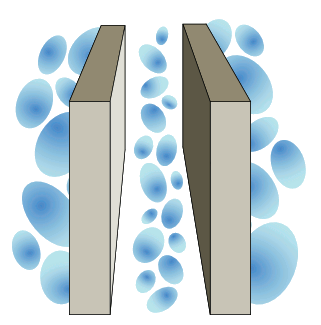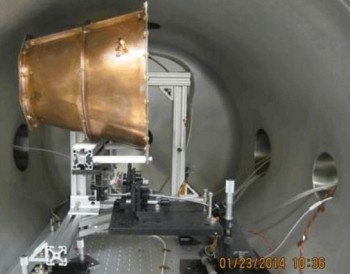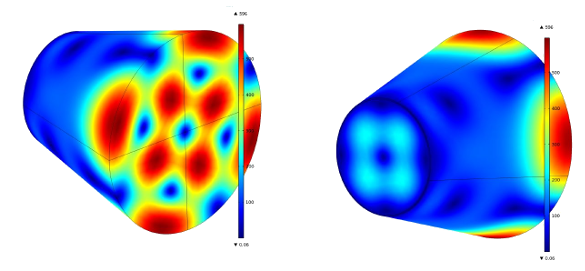Electromagnetic Propulsion
June 11, 2015
While
thermodynamics has a quantity called "
free energy," free in this case just means available. We all know that nothing good can be obtained at no cost. That
idea is summarized by the expression, "
There's no such thing as a free lunch. The
economist,
Milton Friedman, actually used this expression as the title of a
book.[1]
The No Free Lunch idea describes the fundamental
economic principle of
opportunity cost. Opportunity cost is the
money you would have made by selling your
graphite and
wood, rather than transforming them into
pencils for sale.
Over the
centuries, ambitious
inventors have struggled for a free lunch in the form of a
perpetual motion machine. I wrote about such machines in two previous articles (Second Law of Thermodynamics, February 7, 2011, and Perpetual Motion, May 17, 2013).
Physicists don't waste their
energy (
pun intended) on perpetual motion, since it's disallowed by the
first and second law of thermodynamics. The first law of thermodynamics is the conservation of energy law, while the second law states that thermal systems will
equilibrate after sufficient time, and
natural processes are
irreversible.
Thermodynamics has been proven valid for hundreds of years, so physicists are not timid in their belief that perpetual motion is impossible. In 2003, the American Physical Society issued the following statement:
"The American Physical Society deplores attempts to mislead and defraud the public based on claims of perpetual motion machines or sources of unlimited useful energy, unsubstantiated by experimentally tested established physical principles."
The
US Patent and Trademark Office does not grant patents for perpetual motion machines, as explained in its Manual of Patent Examining Procedure (MPEP).
"A rejection on the ground of lack of utility is appropriate when (1) it is not apparent why the invention is “useful” because applicant has failed to identify any specific and substantial utility and there is no well established utility, or (2) an assertion of specific and substantial utility for the invention is not credible. Such a rejection can include the more specific grounds of inoperativeness, such as inventions involving perpetual motion."(Section 706.03a)
Perpetual motion might lurk outside the realm of thermodynamics. One fictional example is the Zero Point Module (ZPM) of the various Stargate television series. The Zero Point Modules apparently harvest the zero-point energy of the vacuum.
Zero-point energy is the ground state energy of the vacuum. The uncertainty principle requires every
quantum mechanical system to have a ground state energy that's greater than zero. One manifestation of this is that there's motion even at
absolute zero. For this reason, every place in the
universe seems to sit atop a baseline energy reservoir, although the term, "reservoir," is a misnomer, since it doesn't appear possible to tap into this energy.
There's an effect involving the vacuum zero-point energy that encourages speculation that this energy can fuel some interesting devices. This is the
Casimir effect, predicted in 1948 by
Dutch physicist, Hendrik Casimir.
Casimir predicted that
very closely-spaced conductors will attract each other in a perfect vacuum. That's because the region between the conductors form an electromagnetic resonator that only supports a subset of the frequency modes of the vacuum state, so the vacuum outside this region, which supports all modes, will exert a pressure on the conductors.

Illustration of the Casimir effect.
The vacuum region outside parallel conducting plates supports all modes, whereas the number of modes allowed between the plates is restricted. There is a net exterior pressure that acts to push the plates together.
(Via Wikimedia Commons))
Ten years after his prediction, Casimir's effect was roughly demonstrated by one of Casimir's colleagues at the
Philips Research Laboratories. An experiment in 1997 demonstrated the Casimir Effect to 95% accuracy.[2] Atomic force microscopy experiments, for which separations can be very small, has brought the agreement to 99%.
It's easy to believe that lurking in the Casimir effect is the means to extract energy from the vacuum. Square centimeter parallel plate conductors separated by ten nanometers have an attractive force of 10 newtons, or one kilogram of force! The problem, however, is that the same force is needed to separate the plates, so any cycle involving movement of the plates will yield no useful
work.
The zero-point state of the vacuum was the first thing that came to my mind when I read reports about a seemingly impossible
propulsion drive being investigated by
scientists at
NASA.[3] It appears that forces defying
conservation of momentum are exhibited by closed,
asymmetric,
microwave cavities. This concept originated with the
UK company,
Satellite Propulsion Research Ltd., in 2001. Since the device violates a
fundamental law of
mechanics, it might be lumped together with perpetual motion machines, and no one was interested in further experiments until recently.
About a year ago, a team of NASA scientists led by
Harold White at the
Johnson Space Center presented positive results in follow-up experiments at the
50th AIAA/ASME/SAE/ASEE Joint Propulsion Conference,
Cleveland, Ohio, July 28-30, 2014.[4] Evidence was presented for a direct conversion of
electrical energy to
thrust without
propellant. The NASA work followed work by
Chinese scientists in which 0.720
newtons of thrust was obtained with 2.5
kilowatts of
electrical power.[3,5]
When so much electrical power is involved, there's always the problem that
heating of the object might cause
convective forces in the surrounding
Air that cause the propulsion. That's why the Chinese instrumented their experiment with
temperature sensors. In the most recent experiments, the NASA research team tested their device in a
vacuum chamber, which nullified the
hypothesis that the thrust came from thermal convection.[3]

The electromagnetic propulsion device in a vacuum chamber. Experiments in vacuum eliminate the possibility that the propulsion forces arise from thermal convection.
(NASA photo.)
As I discussed in a
previous article (The Pioneer Anomaly, December 19, 2012),
photons emitted by an object will impart momentum, but the observed propulsive thrust is several thousands times greater than such an effect. The NASA team believes that
virtual particle pairs from the quantum vacuum are acting as propellant
ions, and the device is a type of
magnetohydrodynamic drive.[3] The problem with this interpretation is that it's supposedly impossible to
ionize the quantum vacuum; and, even if you do, you can't really "push" against it.[3]

Magnetic field distribution in the NASA electromagnetic propulsion device. Asymmetry is a necessary requirement for propulsion in a preferred direction.(NASA illustration.)
Whatever the cause of the propulsion, the NASA team was able to calculate the
efficiency of their device, about one newton per kilowatt.[3] The efficiency appears to increase as the power increases. An input power of 100 kilowatts is calculated to give about 1300 newtons of thrust. As if a drive operating via the quantum vacuum wasn't speculative enough, the NASA research team is performing experiments with an
interferometer to see whether time-varying electromagnetic fields could distort
spacetime.[3]
References:
- Milton Friedman, "There's No Such Thing as a Free Lunch," Open Court Publishing Company, 1975, ISBN 087548297X (via Amazon).
- S. K. Lamoreaux, "Demonstration of the Casimir Force in the 0.6 to 6 μm Range," Phys. Rev. Lett. vol. 78, no. 1 (January 6, 1997), pp. 5-8.
- José Rodal, Jeremiah Mullikin and Noel Munson, "Evaluating NASA's Futuristic EM Drive," NASA Press Release, April 29, 2015.
- Web Site of the 50th AIAA/ASME/SAE/ASEE Joint Propulsion Conference, Cleveland, Ohio, July 28-30, 2014.
- EM Drive Page on Wikipedia.
Permanent Link to this article
Linked Keywords: Thermodynamics; thermodynamic free energy; idea; There's no such thing as a free lunch; economist; Milton Friedman; book; macroeconomics; economic principle; opportunity cost; money; graphite; wood; pencil; century; invention; inventor; perpetual motion; Second Law of Thermodynamics; physicist; energy; pun; First law of thermodynamics; conservation of energy; temperature; thermal; system; thermodynamic equilibrium; equilibrate; nature; natural; irreversible process; American Physical Society; statement; US Patent and Trademark Office; patent; Manual of Patent Examining Procedure (MPEP); Section 706.03a; science fiction; fictional; Zero Point Module; Stargate; television series; zero-point energy; vacuum state; ground state; uncertainty principle; quantum mechanics; quantum mechanical system; motion; absolute zero; universe; thermal reservoir; Casimir effect; Dutch; physicist; Hendrik Casimir; nanoscopic scale; electrical conductor; electromagnetism; electromagnetic; resonator; frequency mode; pressure; parallel; colleague; Philips Research Laboratories; experiment; accuracy; atomic force microscopy; square centimeter; nanometer; newton; kilogram-force; thermodynamic cycle; work; propulsion drive; scientist; NASA; conservation of momentum; asymmetry; asymmetric; microwave cavity; United Kingdom; UK; Satellite Propulsion Research Ltd.; physical law; fundamental law; classical mechanics; Harold White; Lyndon B. Johnson Space Center; 50th AIAA/ASME/SAE/ASEE Joint Propulsion Conference; Cleveland, Ohio; electrical energy; thrust; propellant; China; Chinese; newton; kilowatt; electrical power; heat; heating; convection; convective; air; thermometer; temperature sensor; vacuum chamber; hypothesis; electromagnetism; electromagnetic; propulsion; vacuum chamber; thermal convection; photon; quantum fluctuation; virtual particle pair; ion; magnetohydrodynamic; ionization; ionize; magnetic field; asymmetry; efficiency; interferometry; interferometer; spacetime.